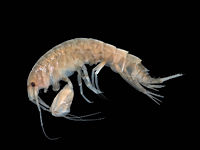Portal:Crustaceans
The Crustaceans Portal Crustaceans are a group of arthropods that are a part of the subphylum Crustacea (/krəˈsteɪʃə/), a large, diverse group of mainly aquatic arthropods including decapods (shrimps, prawns, crabs, lobsters and crayfish), seed shrimp, branchiopods, fish lice, krill, remipedes, isopods, barnacles, copepods, opossum shrimps, amphipods and mantis shrimp. The crustacean group can be treated as a subphylum under the clade Mandibulata. It is now well accepted that the hexapods (insects and entognathans) emerged deep in the Crustacean group, with the completed group referred to as Pancrustacea. The three classes Cephalocarida, Branchiopoda and Remipedia are more closely related to the hexapods than they are to any of the other crustaceans (oligostracans and multicrustaceans). The 67,000 described species range in size from Stygotantulus stocki at 0.1 mm (0.004 in), to the Japanese spider crab with a leg span of up to 3.8 m (12.5 ft) and a mass of 20 kg (44 lb). Like other arthropods, crustaceans have an exoskeleton, which they moult to grow. They are distinguished from other groups of arthropods, such as insects, myriapods and chelicerates, by the possession of biramous (two-parted) limbs, and by their larval forms, such as the nauplius stage of branchiopods and copepods. Most crustaceans are free-living aquatic animals, but some are terrestrial (e.g. woodlice, sandhoppers), some are parasitic (e.g. Rhizocephala, fish lice, tongue worms) and some are sessile (e.g. barnacles). The group has an extensive fossil record, reaching back to the Cambrian. More than 7.9 million tons of crustaceans per year are harvested by fishery or farming for human consumption, consisting mostly of shrimp and prawns. Krill and copepods are not as widely fished, but may be the animals with the greatest biomass on the planet, and form a vital part of the food chain. The scientific study of crustaceans is known as carcinology (alternatively, malacostracology, crustaceology or crustalogy), and a scientist who works in carcinology is a carcinologist. (Full article...) Selected articleHemigrapsus estellinensis is an extinct species of crab, formerly endemic to the Texas Panhandle. It was closely related to species from the Pacific Ocean such as Hemigrapsus oregonensis, but lived 500 mi (800 km) inland in a hypersaline spring. Its occurrence so far from the ocean has been described as "curious", and it was "probably a Pleistocene relic". It differed from its relatives by the pattern of spots on its back, and by the relative sizes of its limbs. H. estellinensis was discovered by Gordon C. Creel in 1962 and was probably already extinct before his description was published in 1964, after the Estelline Salt Springs where it lived were contained by the United States Army to reduce the salt load on the Prairie Dog Town Fork of the Red River. Did you know?
Selected biographyMichèle de Saint Laurent (December 9, 1926 – July 11, 2003) was a French carcinologist. She was born on December 9, 1926 at Fontainebleau, near Paris. She studied general biology at the University of Paris under Pierre-Paul Grassé, earning her Diplôme de Licence in 1954. She started undertaking scientific research even before finishing her degree, and the resulting paper brought her into contact with staff at the Muséum national d'histoire naturelle in Paris. From 1955 until 1960, she worked at the Centre National de la Recherche Scientifique (CNRS), at their laboratory at Banyuls-sur-Mer; thereafter, she returned to the Paris museum. The first major focus of Michèle de Saint Laurent's work was the systematics of hermit crabs. She also investigated other decapod crustaceans, particularly the Thalassinidea. As a result of this work, she was invited in 1974 to visit the Smithsonian Institution and was given an unidentified specimen which had been caught by the Albatross expedition in 1908. She and Jacques Forest realised that it represented a living relative of the Glypheoidea, a group previously thought to have been extinct since the Eocene. They described the new genus together in 1975, as Neoglyphea. De Saint Laurent's later work included a new classification of crabs (involving the recognition of a new section, Eubrachyura), and three new superfamilies (Axioidea, Enoplometopoidea and Retroplumoidea), as well as various works on the decapods of hydrothermal vents. Selected image The Dungeness crab, Metacarcinus magister (formerly Cancer magister), is a species of crab that inhabits East Pacific eelgrass beds and water bottoms from Alaska's Aleutian Islands to Santa Cruz, California. General imagesThe following are images from various crustacean-related articles on Wikipedia.
Crustacean lists
SubcategoriesRelated portalsWikiProjectsAssociated WikimediaThe following Wikimedia Foundation sister projects provide more on this subject:
Discover Wikipedia using portals
|




















































